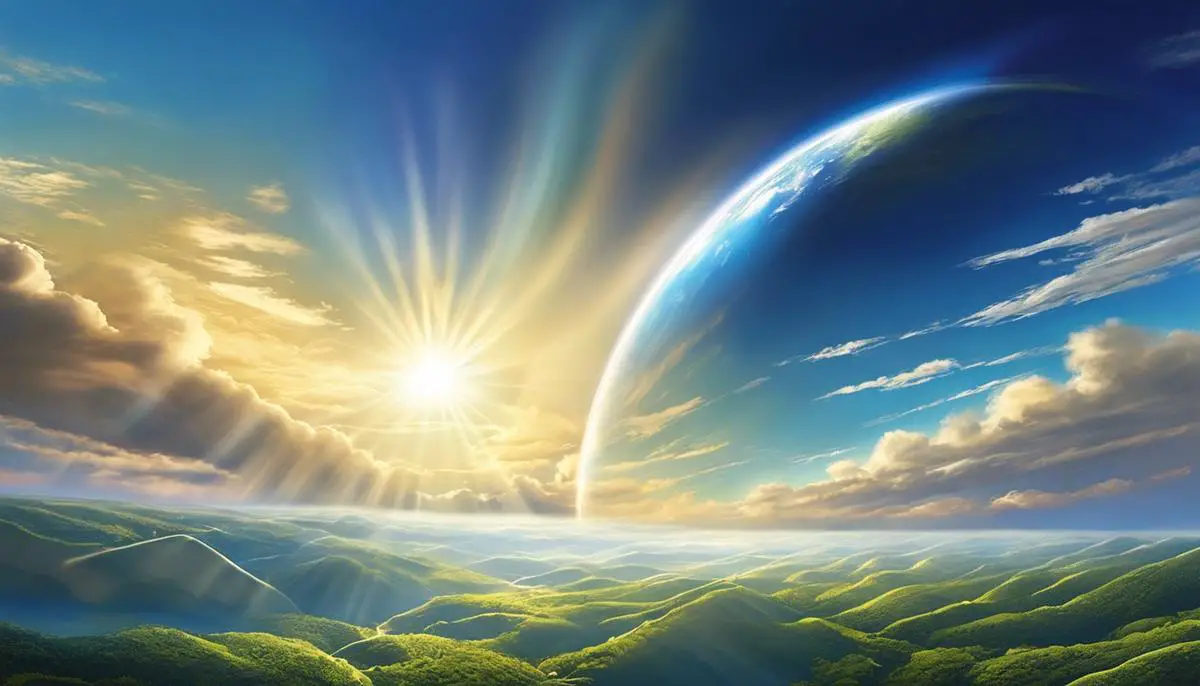As we look up at the sky, we usually observe a bright, vibrant canvas of blue. Yet, a glance upwards on a clear night reveals a stark contrast – a black void studded with distant stars. These seemingly contradictory states of the sky have sparked curiosity and fueled investigation into the heart of how light interacts with our atmosphere and our perceptions. Through a thorough study of light scattering, particularly Rayleigh scattering, we uncover the complex factors responsible for the blue appearance of our skies. Additionally, a tour into the inky darkness of space provides insights into the interplay of cosmic distances, human vision limitations, and the peculiarities of light speed that contribute to its black appearance.
Light Scattering and the Blue Sky
Decoding the Azure Canvas: The Science Behind the Blue Sky
It’s quite a sight to behold, the calming blue sky, an astonishing phenomenon of nature we partake in, day in and day out. But have you ever stopped to ask why the sky is blue? The answer lies in the complex physics of scattering, a fundamental principle of light. Let’s dive in and unmask the science behind the picturesque blue sky.
Light, a form of electromagnetic radiation, is composed of different wavelengths. Shorter wavelengths encompass blue and violet light, while longer wavelengths include red, orange, and yellow, among others. However, the sky doesn’t exhibit a rainbow of colors. So, how does the blue prevail?
The blue sky presents a scientific tale involving particles in the earth’s atmosphere and their interaction with light. To fully grasp this phenomenon, we must delve into Rayleigh scattering, named after the British physicist Lord Rayleigh.
Rayleigh scattering refers to the scattering of light or other electromagnetic radiation by particles much smaller than the wavelength of the light. It explains why the shorter-wavelength blue light is scattered – or in simpler terms, sent off in different directions – more than other colors as it encounters these small particles.
Interestingly, it’s not solitary blue light that is scattered the most. Technically, violet light – having shorter wavelengths than blue – should presumably stain the sky violet. However, the sun emits less violet light to begin with, and our eyes are less sensitive to violet. Furthermore, a part of the violet light gets absorbed by the ozone layer, reducing its scattering effect. Meanwhile, blue light is present in abundance, and our eyes are also more sensitive to blue.
When one looks at the sky, one is not looking directly at the sun, but rather at an angle. At this angle, one is observing the sunlight that has been scattered many times, which results in an azure blanket overhead. This beautifully abstract light-painting procedure transforms the sky into a canvas painted with blue hues.
Therefore, the striking blue color of the daylight sky is chiefly a result of Rayleigh scattering and the peculiar ways light interacts with particles in the earth’s atmosphere, displaying nature’s magnificent observatory of physics.
Interestingly, this scattering effect has different variations during sunrise and sunset, leading to the reddish and orange hues known as the “golden hour.” Yet, the science behind those beguiling colors— influenced by factors such as light path length, atmospheric particles, and more—is a riveting narrative for another day.
As we continue to marvel at the boundless sky above us, let us also acknowledge the fascinating science behind its color. Our understanding of light scattering illuminates not just the mystery of our blue sky but also equips us with broader insights into the realms of physics and atmospheric sciences. Understanding such phenomena better equips us in the pursuit of knowledge about our world and beyond. Isn’t that truly fascinating?

The Darkness of Space
The Universe Bristling With Stars: Understanding Darkness in Space
As we engage in contemplative star gazing on a crisp, clear night, a question often arises: Why is space, teeming with countless luminous celestial bodies, primarily perceived as black? Intuitively, we might expect a dazzling, star-lit spectacle, yet our night skies appear largely dark; this is essentially a manifestation of Olbers’ Paradox.
Named after amateur German astronomer Heinrich Wilhelm Olbers, the paradox posits that the night sky should be ablaze with starlight given the vast, ostensibly infinite Universe teeming with stars. However, our experience counter-intuitively reveals quite the opposite: space is predominantly dark, a stark contrast with the diurnal canvas of azure. To delve into this discrepancy, a few salient facts warrant attention.
Firstly, space and our skies are not entirely devoid of color. Despite the overall appearance of darkness, careful observation reveals speckles of white, red, yellow, or blue dispersed across the infinite expanse. This variation, however, is a consequence of the inherent properties of the stars themselves – their surface temperature, size, and intensity – rather than any atmospheric scattering processes discussed previously.
Next, conferring to the tenets of cosmology, the Universe is both isotropic and homogenous on a larger scale. Meaning, viewed broadly across vast distances and time, the Universe is uniformly filled with galaxies and stars. Yet, these celestial bodies are not evenly distributed, instead grouping into dense clusters separated by vast stretches of empty space. Furthermore, the universe is expanding, which places some objects beyond the observable universe due to the speed of light.
Simultaneously, an understanding of the inversion square law is crucial. As per this principle, the brightness of a star diminishes with the square of the distance from the observer. Consequently, despite the estimated hundreds of billions of galaxies each containing hundreds of billions of stars, the light from a distant star wants in intensity by the time it meets our human eye.
Moreover, the Universe’s age plays an instrumental role. At approximately 13.8 billion years old, there’s simply not had enough time for the light from every star to reach Earth.
Lastlu, there’s a bound to the number of stars we can physically see. This is dictated by the stars’ lifetime and the time it takes light to reach us. Older stars may have already “died,” ceasing their light emission even before their rays could reach us.
Thus, despite the dazzling spectacle of billions of stars, the vast majority of light never graces our nocturnal vision. Its journey impeded by immense distance, decremented intensity, and the fleeting lifespan of stars themselves, convincingly accounts for the blackness of Space. Such inquiries and apparent paradoxes serve to deepen our understanding of the cosmos and its multitudinous, often counterintuitive, intricacies.

Transition from Blue Sky to Black Space
Naturally, one marvels at the stark contrast between the cerulean canopy of the daytime sky and the obsidian abyss observable during nocturnal hours. Indeed, as we transition from day to night, the conspicuous azure hue gives way to a darker, less discernible milieu, embroidered by sparkling stars. This shift is no coincidence nor a painterly whim of Mother Nature—it is all thanks to the very principles that underpin our understanding of the universe.
Emarkably, the answer originates from a puzzling paradox named after physicist Heinrich Wilhelm Olbers, widely recognized as ‘Olbers’ Paradox.’ This conundrum questions why, if the universe houses an infinite number of stars, the sky isn’t ablaze with light even at night. The response to this intrigue is intertwined with the qualitative aspects of our stellar neighbors themselves.
Stars, celestial bodies bestowing the universe with a vast array of hues, are more than meet the eye. Their color results from their temperature; relatively cooler stars radiate energy on the red end of the spectrum while hotter stars emit more blue and white light. Excellent! But what about the abundance of color in space? Why don’t we see these myriad hues reflected in our terrestrial sky? The reasoning, on close examination, lies in the isotropic and homogenous distribution of the universe.
Deciphering the universe purely from an astronomical lens can be deceptive. Given our vantage point, it might seem as though stars are scattered randomly, painting an intricate celestial picture. However, in reality, our universe, on a grander scale, is isotropically and homogeneously structured. Stars congregate into colossal, dense clusters creating galaxies, with vast voids of virtually empty space between them. This cosmic arrangement is crucial in determining the transition from blue to black skies.
Accompanied by the seemingly static facet of the cosmos, a more dynamic phenomenon is concurrently at play—the universe’s perennial expansion. This growth in cosmic boundaries dilutes the concentration of celestial bodies per unit volume, diminishing the gradient of celestial brilliance. It impacts our terrestrial ability to perceive the otherwise overwhelming shower of starlight.
Adding to the subtleties involved in visual reception, another principle—the inverse square law—elucidates the gradual dimming of stars. According to this law, the brightness of a light source fades with the square of the distance. Thus, even stars of monumental luminosity could be relegated to dim specks by the time their light graces our planet.
Lastly, one must contend with temporal constraints. The universe may be old—nearly 13.8 billion years by prevailing estimates—but not all light from all stars has had sufficient time to reach us, let alone continually illuminate our sky. Moreover, the finite lifetime of stars ensures that some knockout into the oblivion before their radiant memoirs ever touch our world.
This rich tapestry of astronomical and physical principles intricately weaves the transition from our daytime blue sky to the nighttime black expanse, singing an ode to the knowledge humans have accrued about our enigmatic Universe. It is a testament to humanity’s perseverance for knowledge, for understanding, and most importantly, for reaching out to the vast, limitless cosmos that beholds us.

From the rich blue of midday to the deep black of midnight, our sky presents a daily display of light’s remarkable journey. Through the perpetual dance of light and particles, a ceaseless spectacle unfolds against the backdrop of our atmosphere, challenging and delighting our perceptions. Delving into Earth’s atmospheric layers, we unravel the ethereal transition from the sky’s blue to the void’s black. Such an investigative journey reminds us of our constant interaction with the natural world, inviting us to marvel at the ordinary and extraordinary phenomena it displays across our skies and beyond.
![]()
